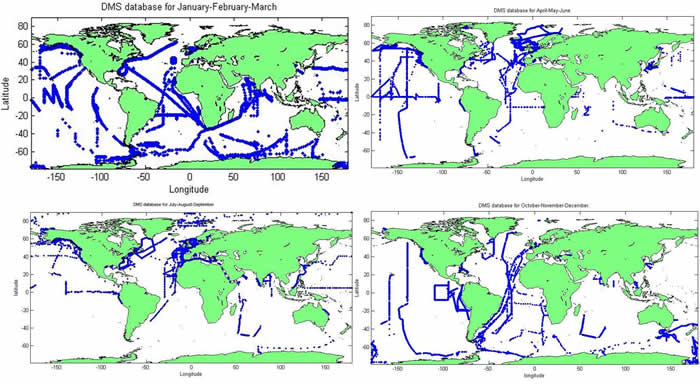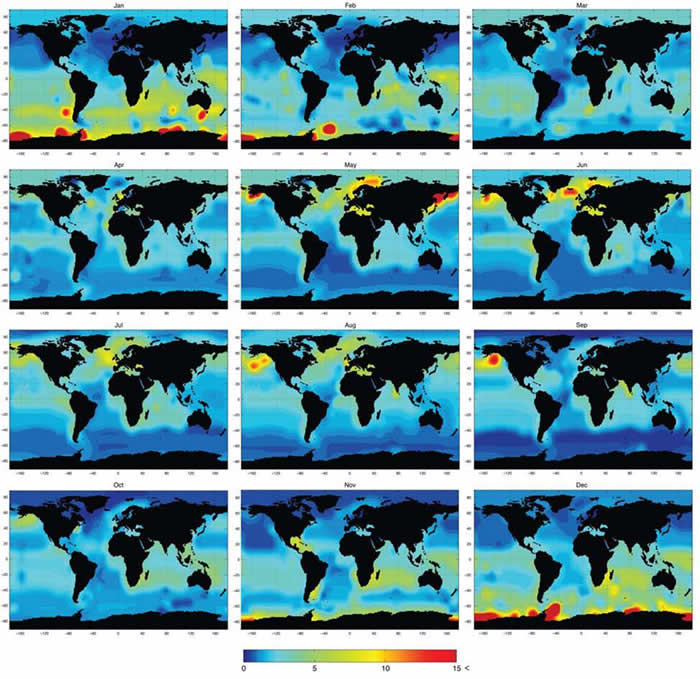
The biogenic trace gas DMS is well known for its role in the proposed CLAW hypothesis (Charlson et al., 1987). In terms of data archiving, this compound is the most advanced in SOLAS Integration in part due to the work of Jamie Kettle, who initiated the collation of the original database of 15,617 global surface DMS concentration measurements (Kettle et al., 1999). These sea surface DMS concentrations are presented as a series of monthly maps with 10x10 latitude longitude resolution, produced using a simple data apportionment and interpolation/extrapolation scheme using the 57 biogeochemical provinces as developed by Longhurst (1995).
The results of the Kettle et al. (1999) climatology show a distinct annual cycle in sea surface DMS concentrations in both the northern and southern hemisphere high and mid-latitudes, with the southern hemisphere peak shifted by 6 months. The Kettle et al., (1999) climatology, in addition to a small number of additional measurement data, was used to estimate the flux of DMS from the global ocean, and the results published in Kettle and Andreae (2000). These results estimate an annual global flux of 15, 21 and 33 Tg (Teragrams) S yr-1, using the parameterisations of Liss and Merlivat (1986), Erickson (1993) and Wanninkhof (1992) respectively.
Since the work of Jamie Kettle, the scientific community has worked with SOLAS Integration and Dr Tom Bell to construct an up-to-date DMS database. As a result, the global surface ocean DMS database has been increased threefold, from 15,617 measurements (in 1999) to 47,250 (in April 2010). For access to this database please click the following link: http://saga.pmel.noaa.gov/dms/.
The updated DMS database for January-February-March, April-May-June, July-August-September, October-November-December has been used to show locations where data is currently available.

Based on the updated DMS database, a research project was initiated to estimate the air-sea flux of DMS. This project was primarily funded by European Network of Excellence for Ocean Ecosystems and Analysis (EUR-OCEANS) as well as funding from the European COoperation in Science and Technology (COST) Action 735 and the SOLAS International Project Office (IPO). This work stands as a joint initiative between the Institut de Ciencies del Mar de Barcelona (ICM-CISC) and the University of East Anglia, UK.
Using the updated DMS database, Lana et al., (2010, get PDF copy) have re-estimated the sea-to-air DMS flux to be ~28.1 Tg S yr-1; 17% more with respect to the previous climatology. The Lana 2010 climatology offers an improved representation of global sea surface DMS concentrations because of the increased number of measurements and their increased spatial and temporal coverage (Lana et al., 2010). Plots of the DMS climatology are shown in Lana et al. (2010).

SOLAS Integration is committed to making the DMS concentration climatology products available to the community. Download the monthly DMS concentration climatology (in .csv format, one file per month).
In addition, an assessment has been made of the uncertainty in the DMS climatology estimates. Download a .zip file containing the upper and lower bounds.
Finally, an un-extrapolated 10x10 climatology of the data would be a very useful tool for oceanic model validation. As part of the work of Lana et al. (2010), a ‘standard’ 10x10 climatology was produced to aid the comparability of different model validation exercises. Download the standard climatology.
Implementation Group 1 also examines these other short-lived components:
Organohalogens | Alkyl nitrates | Isoprene | Methanol | Ammonia | Aerosol and rain